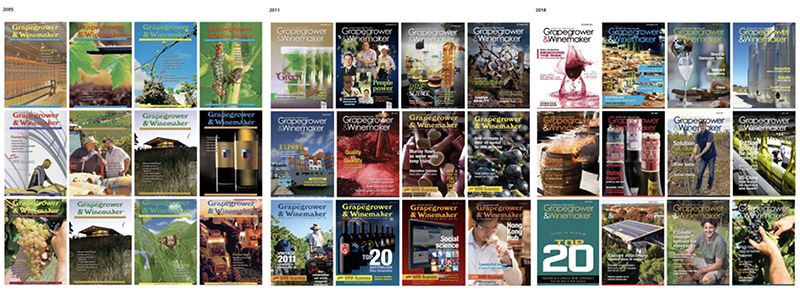In this article published in the August issue of the Australian & New Zealand Grapegrower & Winemaker magazine, Meininger’s Wine Business International’s editor in chief Felicity Carter chats ahead of her keynote speech at the Wine Industry IMPACT Conference in Orange on 17-18 September.
Ahead of her keynote address at the 2019 Wine Industry Impact Conference in Orange this September, we asked Felicity Carter — wine judge and editor-in-chief of Meininger’s Wine Business International — for her thoughts on the main challenges facing the wine industry today.
Recently returned from speaking at the MUST International Wine Tourism Conference in Portugal, Carter, an Australian now based in Europe, has the benefit of a truly global view, and outlined seven areas across four main sectors — environment, health lobby, industry practice and disruptors — as food for thought.
Climate change
This one won’t be a surprise to anyone living in Australia, but the fact that Bordeaux AOC — Bordeaux! One of Europe’s most traditional regions – has recently voted to introduce new grape varieties as a way of grappling with climate change is a sign of how serious and urgent the problem is. In Europe we’ve seen heatwaves that have left vines looking as though a fire has passed over them and major droughts affecting Central Europe.
While the wine industry generally has been very proactive about dealing with climate change, from capturing fermentation carbon to trialling new varieties, this is ultimately a political problem. Unfortunately, there are few signs that governments are taking this problem as seriously as they should.
Water
Should countries be exporting precious water in bottles of cheap wine? Will people become resentful of the wine industry’s use of water, as happened in South Africa? Consumers and gatekeepers aren’t yet talking about water usage, but that day can’t be far off, and the global wine industry will have to justify its use of irrigation.
Sustainability
Already, influential buyers in key markets like Sweden are prioritising wines that have been produced with a low environmental impact.
Certifications are becoming more important and consumers are asking more questions about how the grapes were farmed.
But some of the best grapes come from the most marginal climates, where it can be risky to go organic. What will the wine world do when even small amounts of fungicides, pesticides and herbicides are no longer acceptable — a day which is not far off? Will viticulture become a small-scale or very labour-intensive affair again, as it was in the past? What will this mean for owners of very big vineyards?
Wine labelling
Within the next five years, if not sooner, wine sold in the EU will have to have an ingredients label. This means wine heading to some of the world’s most important markets (Sweden, Germany, Ireland) will have to reveal how the wine has been made. This will, inevitably, make ingredient labelling the international standard. For many consumers, finding out that there is more in some of their wines than fermented grape juice will be a shock. How will they react? If I had to make a prediction, it would be that minimal-intervention wineries will be the winners with consumers.
The health lobby
As governments stare down the ‘silver tsunami’ — an ageing population in increasing need of expensive health care — they will get increasingly vocal about the dangers of alcohol. We’ve already seen the World Health Organisation declare that there is no safe level of alcohol. For a long time, the wine trade has imagined that it’s immune from the effects of these warnings, coasting on the belief that wine in moderation is good for you. This won’t work any more — and worse, it may see the wine trade accused of the tactics of Big Tobacco.
The only way to deal with this is to be absolutely squeaky clean, particularly when it comes to influencer marketing. Any wine company that pays, hosts or sponsors influencers must insist that the relationship is clearly laid out in the hashtags.
The wine trade in general, and wine writers in particular, should be wary of making or repeating health claims about wine. This doesn’t mean that the wine industry can’t push back at bad science, only that the conversation is best led by qualified medical and scientific professionals.
The rise of the ‘sober curious’ movement
The combination of social media plus loud health warnings is having an effect — more and more people are giving up alcohol altogether. Younger people understand that they may pay a career or
personal price if they are seen drinking too much, or being drunk on social media. Older people want to optimise their health and well-being. We may well be facing a neo-prohibitionist movement.
While the beer industry has managed to create a raft of popular low- and no-alc products, the wine industry still struggles. The basic problem is that nobody yet (apart from some sparkling producers) knows how to make a no-alc wine taste like real wine. These products won’t be a viable option for most of the wine industry for the foreseeable future — and maybe that’s not a bad thing. Wine isn’t about selling beverages to people, but about wine.
Opportunistic brands
Private label wines used to be the preserve of wine clubs and some big supermarkets, but now they’re spreading everywhere. An increasing number of clubs, retailers, supermarkets, distributors and HoReCa establishments in the USA, UK, Germany and other key markets are creating their own brands and filling the bottles with interchangeable bulk wine. This means less shelf space and less opportunity for wineries to sell their own brands. Wineries are increasingly going to have to sell their wines directly, either through direct-to-consumer or through wine tourism or a combination of both.
Australians should also be vigilant about the opportunistic wines made from Australian bulk that are turning up in China. While some of these flash-inpan wines are created by the Chinese themselves, others are being created by Australians in search of short-term profit and they will hurt Australia’s excellent reputation in this key market.
Solutions
While this all sounds pretty dire, it’s not. People are absolutely craving authenticity and connection with the earth, and an alternative to corporate culture, and wine can deliver that.
The wine trade actually stands for something — for sitting down and enjoying each other’s company and taking the time to appreciate good food and other people. For family and community. Those are very powerful values, and they weren’t cooked up in a brand meeting — they’re the fundamental reason why people get into this business.
Australian wineries in particular have a real opportunity to tell that story. Old World vignerons are, for deep cultural reasons, reluctant to talk about hardship, and generally reluctant to talk up their neighbours. Australians can talk about their land in a different way — not just about terroir, but about forging a relationship with land because of working with it through both good and bad times. That’s a very strong and memorable type of story. Australians can also talk about the value of community and sharing with others, in a real and authentic way.
Part of being a winemaker now is having to stand and deliver a ten-minute talk, whether it’s at a formal wine dinner in Hong Kong, or to a potential distributor, or to visitors at the cellar door. The wine trade has developed a kind of ‘universal story’ that doesn’t work very well these days, because everybody uses it. Everybody has heard it: “We’re a family owned winery who are passionate about our wines, and our wines are made in the vineyard.”
Felicity Carter will deliver a down-to earth guide to what wine consumers of today are looking for and how to elevate your brand to achieve wine stardom at the Wine Industry Impact Conference in Orange this September. Find out more about the Wine Industry IMPACT Conference at www.wiic.com.au
This article was originally published in the August issue of the Australian & New Zealand Grapegrower & Winemaker magazine. Subscribe to read more articles like this.
When you subscribe, you get:
Your choice of print copy subscription or digital-only subscription!
Both types of subscription include:
Digital access to all Grapegrower & Winemaker issues since 2005
Access to download PDF versions of full magazines and single articles
Subscribe today
To preview the latest magazine, click here.
To subscribe, click here.






















